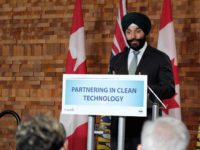The release of today’s federal budget is expected to include a significant emphasis on innovation, with the government revealing how it plans to spend (or re-allocate) hundreds of millions of dollars that is intended to support innovation. Canada’s dismal innovation record needs attention, but spending our way to a more innovative economy is unlikely to yield the desired results. While Navdeep Bains, the Innovation, Science and Economic Development Minister, has talked for months about the importance of innovation, Toronto Star columnist Paul Wells today delivers a cutting but accurate assessment of those efforts:
Latest Posts
Panel Rejects Eli Lilly Claim Over Canadian Patent Law, Orders Company to Pay Millions in Costs
In the early 1990s, Eli Lilly applied for patent protection in Canada for two chemical compounds, olanzapine and atomoxetine. The company had already obtained patents over the compounds, but asserted that it had evidence to support new uses for the compounds that merited further protection. The Canadian patent office granted the patents based on the content in the applications, but they remained subject to challenge.
Both patents ultimately were challenged on the grounds that there was insufficient evidence at the time of the applications to support the company’s claims. The Federal Court of Canada agreed, invalidating both patents. Eli Lilly proceeded to appeal the decision to the Federal Court of Appeal and later to the Supreme Court of Canada. The company lost the appeals, as the courts upheld the decision to invalidate the patents.
Under most circumstances, that would conclude the legal story as several Canadian courts reviewed Eli Lilly’s patent applications and ruled that they failed to meet the standards for patentability. Yet in June 2013, the company served notice that it planned to use the ISDS provisions in the North American Free Trade Agreement to claim that in light of the decisions, Canada was not compliant with its patent law obligations under the treaty. As compensation, Eli Lilly sought at least $500 million in damages.
Scare Tactics Down Under: The Ongoing Global Effort to Mislead on Canadian Copyright
Last month, I traveled to Australia and New Zealand as part of a group of experts to discuss copyright fair use and fair dealing. The trip included several public talks, meetings with government officials, a book launch on Reimagining Copyright, and the chance to discuss copyright policy directly with publishers, educators, and librarians. Videos of some of the panels are available online, including a New Zealand forum on copyright and innovation and a panel on comparative copyright limitations and exceptions at the Australian Digital Alliance annual conference.
Among the most notable aspects of the trip was the revelation of efforts by publishers and copyright collectives to mislead policy makers on the state of copyright law in Canada. While not everyone is buying it – this keynote from the Australian Productivity Commission’s Deputy Chair Karen Chester was a mic drop moment that eviscerated the publisher arguments against fair use – the efforts to mislead on the impact of Canadian copyright reform was unmistakable. For example, at one event with many publishers in the audience, I was approached by one representative who told me she was embarrassed by what her company had submitted to the Australian policy process after learning about the reality of the situation in Canada. Similarly, another Australian publisher executive who had spent years with one of Canada’s largest educational publishers, openly acknowledged that fair use and fair dealing had little to do with the challenges faced by the industry.
The Netflix Effect?: Foreign Sources Outspend Canadian Broadcasters and Distributors for English TV Production
The Canadian Media Producers Association recently released its annual report on the state of screen-based media production in Canada. Despite the doomsayers who fear that the emergence of Netflix will result in less money for production in Canada, the report confirms that financing of Canadian television production continues to grow, reaching its highest point in the last five years. With $2.6 billion spent on Canadian television production, the sector remains healthy with support from licensing fees, tax credits and funding from a variety of sources.
More notable, however, is the growth of English-language Canadian television production, which has been backed with a major increase of foreign funding over the past three years. Foreign financing of Canadian English-language television production now exceeds all other sources of funding, with the exception of the combination of all provincial tax credits (both represent 18% of total financing). In other words, foreign financing now contributes more toward English-language television production than the licensing fees paid by private or public broadcasters, federal tax credits, Canadian distributors, and the Canadian Media Fund.
Yes We Scan: Why Concordia Should Not Shelve Its Book Scanner
The copyright mistake at Concordia – a poetry centre scanned several books and posted them on the Internet without permission – has attracted considerable attention in the press and social media. Kate Taylor wrote a Globe and Mail column placing much of the blame at the feet of fair dealing, while I responded with a post yesterday that noted that no one claimed that the posting of the full-text books was permissible and that Concordia was an ill-advised target for fair dealing criticism given that it has a copyright collective licence with Copibec that compensates for copying on campus.
While the focus of the Taylor column and my response was on fair dealing and collective licensing, the Taylor column also included several references to the use of a scanner to digitize books. In particular, it concludes by stating that “Ottawa needs to plug that education loophole good before somebody tries to drive a $10,000 book scanner right through it.”











